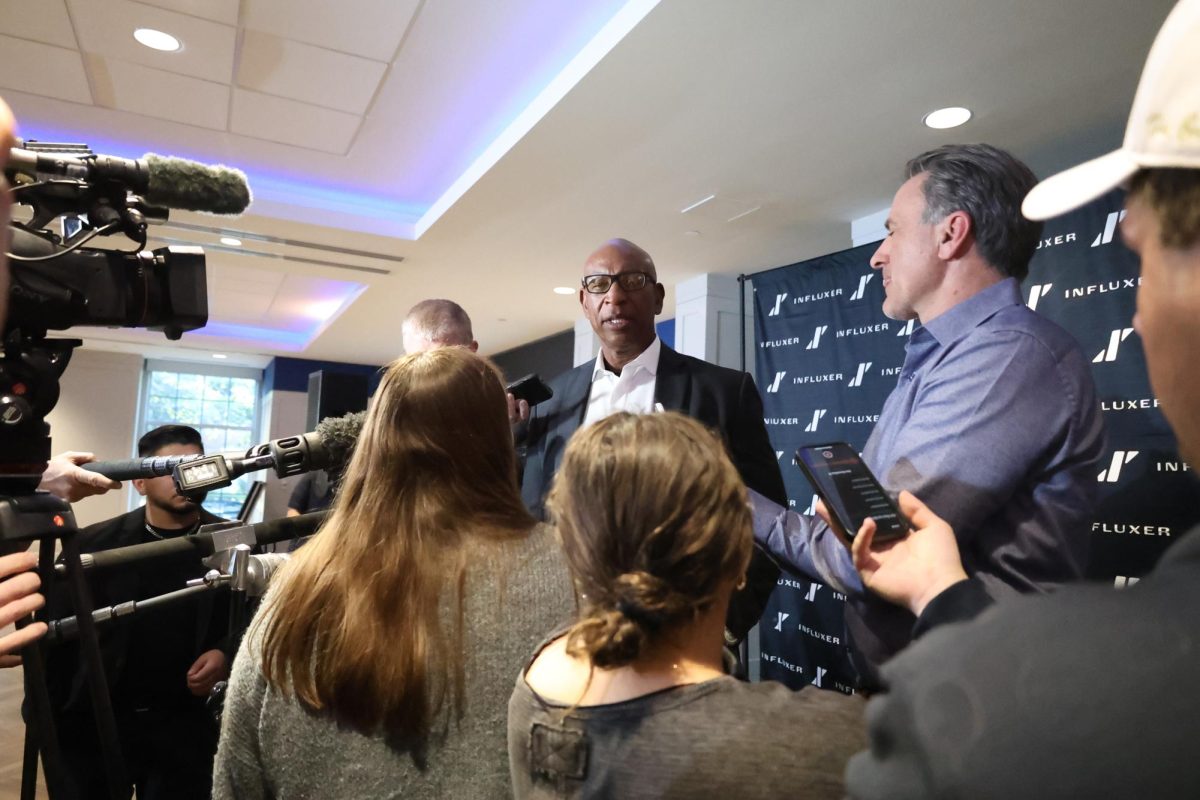
Making sense of college dollars
Before the challenges of books, 10-page papers and exams,college students face a more daunting test before even arriving atthe ivory towers: finding a way to finance their collegeeducation.
From Pell grants and federal loans to pre-paid tuition plans anddebt consolidation, navigating the various options for financialaid can be more difficult than the semester itself.
“For the most part, we tend to be a responsiveservice,” said Mike Novak, the executive director ofEnrollment Services and Financial Aid . “Someone mustidentify their needs to get plugged in.”
The 2003-2004 school year may present new financial challengesto students due to big changes in the field of student finance. TheHigher Education Act, legislation that provides students withfederal money through Pell grants and federal loans, is up forrenewal this year, and the private student-loan industry withgiants like Sallie Mae is continuing to grow, filling the voidswhere federal aid and scholarships fall short.
With this article, The Daily Campus begins a five-partseries on the state of financial aid in America. Throughout theseries, we hope to enter the quagmire and make sense of all theoptions available to students. In the process, we hope that ourreaders will pick up more information on the options available tomeet their financial needs and the risks that each optionposes.
Here are some of the topics on our radar for this year:
Crisis in paid tuition plans
Across the country, states have faced budget crises in 2003 as apoor economy limited the funds available to appropriations.
One of the casualties of this predicament may be pre-paidtuition plans such as the Texas Guaranteed Tuition Plan (formerlythe Texas Tomorrow Fund), which allow parents to lock in currentstate tuition rates years in advance of their child’smatriculation by investing early.
The gamble for parents is that tuition prices will raise more inthe years before their child heads to college than theirparent’s investments would if they saved the money on theirown.
However, due to soaring tuitions at state schools, poor stockmarket performance and these state budge troubles, the parents arewinning that gamble and cashing in at tuition time.
In Texas, the legislature’s vote to deregulate tuition atstate schools has further complicated these risks. Starting withthe spring 2004 semester, state schools in Texas no longer facecaps on their tuition levels.
This legislation could save parents enrolled in Texas’sprepaid tuition plans and sending kids to college in the fall of2004 a goldmine. On the other hand, the Texas Guaranteed TuitionPlan may be paying tuition for students at higher levels than everexpected.
“I was really surprised that while the legislature was insession there was still a strong campaign to enroll new investorsdespite [tuition deregulation].”
Although the state’s comptroller says the institution hasenough money to pay benefits to enrolled parents until 2019, heroffice has closed the Texas Guaranteed Tuition Plan to new members”for the foreseeable future.”
What does this mean for private schools like SMU? If tuitionlevels at Texas’ flagship schools reach levels closer tothose of private institutions, Novak believes that some parentswill take a second look at schools like SMU.
“I have a hard time seeing anything but benefit forus,” he said.
The Higher Education Act: Reauthorization 2003
As the Higher Education Act, the legislation that authorizesspending for federal aid for higher education, comes up for renewalin 2003, a number of groups are fiercely lobbying to have their ownneeds met.
However, almost all groups agree that the current limits offederal financial aid, which haven’t been increased in years,are rapidly losing purchasing power.
The Bush administrations 2004 budget request for federalstudent-aid programs directs all available money to wiping out thebudget shortfall for Pell Grants, aid given without expectation ofrepayment to low-income students, by increasing Pell spending from$1.9 billion to $12.7 billion dollars.
Under the new plan, 4.9 million students could receive Pellgrants, according to an article in The Chronicle of HigherEducation. That’s 1 million more than when Bush firstcame into office.
However, professional associations representing colleges such asthe National Association of Student Financial Aid Administratorssuggest that raising the caps on Pell grants would be moreeffective than channeling more money into the program.
The maximum award for the grants still remains at the $4,000level – a cap that was set three years ago.
As state tuitions soar and inflation continues its slow march,this award is providing less and less help for low-income students,Novak said.
In 1975, the maximum Pell grant paid for 84 percent of theannual cost of a public college education, according to theNational Postsecondary Aid Study by the Department of Education. In2000, Pell grants could only cover 39 percent.
While Pell grants may be an ideal option for students becausethey do not have to be repaid, many lobbying groups representinghigher education are hedging their bets and urging theadministration to focus on increasing caps on federal subsidizedloans.
The current loan caps have perhaps less overall purchasing powerthan the Pell grants. Limits on federal subsidized loans have notbeen raised in 10 years.
Currently, a student can borrow $2,625 their first-year and$23,000 over their entire career. The first-year cap, set in 1986,then covered 25 percent of the price at an average private college.Today, it covers 14 percent, according to the Department ofEducation study.
“Although we’d all like to see an rise in Pellgrants,” Novak said. “Most of the associationsgrudgingly admit that facing limited funds in the budget, the mostlikely increases we can aim for are at the loan level. Given thebudget deficits, we think we’d see more dollars in morestudents hands with loans.”
But past reauthorizations of the act, the legislature is beingbombarded with a number of different recommendations.
While groups representing private institutions are reluctantlypushing the increase of loan limits as a realistic solution.Community colleges and student groups are putting heavy emphasis onPell grants alone focusing on the needs of their students.
“There is the fear that if our recommendations to Congressfracture, everyone is going to lose and [higher education] is goingto be the low man on the totem pole when it comes toappropriations,” Novak said. “In any case, it’sgoing to be a real interesting reauthorization.”
Sallie Mae rising
As the purchasing power of federal student-aid decreases, manystudents may be awarded maximum aid and still be short.
“We’ve got a lot of folks here that are middleincome and still need a lot of aid to meet SMU’scosts,” Novak said. “Private loans have mushroomed inthe past five years.”
Private lending companies such as Sallie Mae Corporation, thenation’s largest private lender for student loans, have risento fill the gaps. Private borrowing by students rose to $5 billionin the 2001-2002 school year, according to a study by the CollegeBoard. In 1995-1996 school year, students borrowed $1 billion fromprivate lenders.
Unlike federal subsidized loans, these private loans may be setat higher interest rates that may not be subsidized over the termof the student’s college career.
However, because of aggressive advertising tactics, a number ofstudents are flocking to companies such as Sallie Mae to helpfinance their career before they’ve exhausted their federalborrowing options.
About half the students who borrow private loans rather thanfederal loans take on debt unnecessarily, according to a May reportby the State Public Interest Research Groups’ HigherEducation Project.
With their increased stake in college financing, companies likeSallie Mae are funneling more and more money into lobbying groupsand campaign contributions in hopes of influencing legislation.
The terms of the reauthorization of the Higher Education Actcould result in major changes to the popularity of the private loanindustry.
Consolidating away debt
This year, interest rates are expected to drop to 3.42 percentfrom 4.06 percent. Three years ago the rate was more than 8percent.
For recent graduates, these low interest rates offer evengreater prospects.
Under a consolidation program created in 1986, graduates areable to consolidate their federal loans with a fixed interest rateset at the time of consolidation. Graduates can take up to 10 yearsto pay of all of their student loans at today’s low interestrates despite fluctuations in that rate over that period.
With sinking interest rates, debt consolidation is becoming anever more popular option. In 2001-2002, borrowers consolidated $17billion in loans – twice as much as the year before.
However, the recent drop in interest rates threaten to damagelenders’ profit margins.
As a result, Sallie Mae and other private lenders as well as theConsumer Bankers’ Association are avidly lobbying to put avariable rate on consolidated loans.
Whether or not Congress will draft legislation addressingstudent debt consolidation in the coming years, thousands ofgraduates are rushing to set-up fixed rate consolidation in fearthat the option will soon be no longer available
College debts, social defecits
A 1998 study by Nellie Mae Corporation found a quarter ofprivate college grads and 40 percent of new medical and law schoolgrads had loan obligations that exceeded their salaries.
Over the past 8 years, the average student debt after graduationhas nearly doubled to $16,928, according to the College Board.
As more and more students are leaving their college yearssaddled by debt, the nation must face a few unexpectedconsequences.
High debt levels lure students away from government, publicinterest and arts and humanities jobs to their equivalents in theprivate sectors.
Over the coming years, we may see unsettling changes in ourcountry’s governmental makeup, nonprofit sector andhumanities due to the number of graduates leaving collegescrambling to find money to live on and to pay off their debts.
Talk of money and legislative debate is usually enough to makethe average student’s eyes glaze over, but this year thearena of financial aid just might get interesting.








